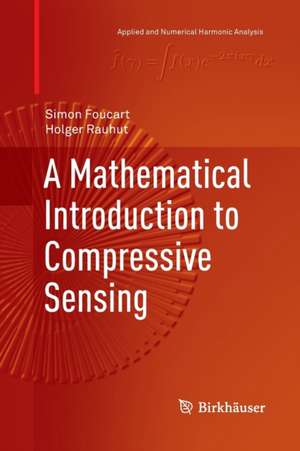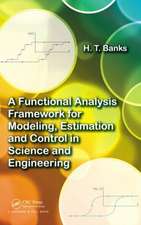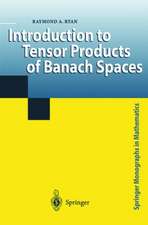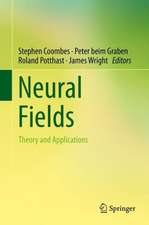A Mathematical Introduction to Compressive Sensing: Applied and Numerical Harmonic Analysis
Autor Simon Foucart, Holger Rauhuten Limba Engleză Paperback – 18 aug 2015
A Mathematical Introduction to Compressive Sensing gives a detailed account of the core theory upon which the field is build. With only moderate prerequisites, it is an excellent textbook for graduate courses in mathematics, engineering, and computer science. It also serves as a reliable resource for practitioners and researchers in these disciplines who want to acquire a careful understanding of the subject. A Mathematical Introduction to Compressive Sensing uses a mathematical perspective to present the core of the theory underlying compressive sensing.
| Toate formatele și edițiile | Preț | Express |
|---|---|---|
| Paperback (1) | 474.56 lei 6-8 săpt. | |
| Springer – 18 aug 2015 | 474.56 lei 6-8 săpt. | |
| Hardback (1) | 550.04 lei 3-5 săpt. | |
| Springer – 8 aug 2013 | 550.04 lei 3-5 săpt. |
Din seria Applied and Numerical Harmonic Analysis
-
 Preț: 399.29 lei
Preț: 399.29 lei - 20%
 Preț: 673.02 lei
Preț: 673.02 lei - 17%
 Preț: 431.76 lei
Preț: 431.76 lei - 19%
 Preț: 443.08 lei
Preț: 443.08 lei -
 Preț: 412.57 lei
Preț: 412.57 lei - 15%
 Preț: 550.04 lei
Preț: 550.04 lei - 15%
 Preț: 653.98 lei
Preț: 653.98 lei - 18%
 Preț: 1014.28 lei
Preț: 1014.28 lei - 15%
 Preț: 647.92 lei
Preț: 647.92 lei -
 Preț: 413.37 lei
Preț: 413.37 lei - 15%
 Preț: 648.74 lei
Preț: 648.74 lei - 15%
 Preț: 654.77 lei
Preț: 654.77 lei - 15%
 Preț: 636.80 lei
Preț: 636.80 lei - 15%
 Preț: 532.89 lei
Preț: 532.89 lei - 15%
 Preț: 646.62 lei
Preț: 646.62 lei - 15%
 Preț: 653.98 lei
Preț: 653.98 lei -
 Preț: 397.38 lei
Preț: 397.38 lei - 15%
 Preț: 656.43 lei
Preț: 656.43 lei - 15%
 Preț: 661.97 lei
Preț: 661.97 lei - 18%
 Preț: 957.13 lei
Preț: 957.13 lei - 24%
 Preț: 829.74 lei
Preț: 829.74 lei -
 Preț: 398.35 lei
Preț: 398.35 lei - 20%
 Preț: 569.86 lei
Preț: 569.86 lei -
 Preț: 392.21 lei
Preț: 392.21 lei - 18%
 Preț: 1121.76 lei
Preț: 1121.76 lei - 18%
 Preț: 1001.32 lei
Preț: 1001.32 lei -
 Preț: 387.75 lei
Preț: 387.75 lei - 15%
 Preț: 653.98 lei
Preț: 653.98 lei - 20%
 Preț: 567.32 lei
Preț: 567.32 lei - 20%
 Preț: 573.77 lei
Preț: 573.77 lei -
 Preț: 406.80 lei
Preț: 406.80 lei -
 Preț: 387.38 lei
Preț: 387.38 lei - 5%
 Preț: 1168.71 lei
Preț: 1168.71 lei -
 Preț: 400.85 lei
Preț: 400.85 lei -
 Preț: 398.15 lei
Preț: 398.15 lei - 15%
 Preț: 644.49 lei
Preț: 644.49 lei - 19%
 Preț: 575.84 lei
Preț: 575.84 lei - 15%
 Preț: 703.71 lei
Preț: 703.71 lei - 20%
 Preț: 334.71 lei
Preț: 334.71 lei - 15%
 Preț: 525.54 lei
Preț: 525.54 lei -
 Preț: 405.06 lei
Preț: 405.06 lei - 15%
 Preț: 536.96 lei
Preț: 536.96 lei
Preț: 474.56 lei
Nou
Puncte Express: 712
Preț estimativ în valută:
90.81€ • 97.10$ • 75.71£
90.81€ • 97.10$ • 75.71£
Carte tipărită la comandă
Livrare economică 18 aprilie-02 mai
Preluare comenzi: 021 569.72.76
Specificații
ISBN-13: 9781493900633
ISBN-10: 1493900633
Pagini: 625
Ilustrații: XVIII, 625 p.
Dimensiuni: 155 x 235 x 33 mm
Greutate: 0.89 kg
Ediția:Softcover reprint of the original 1st ed. 2013
Editura: Springer
Colecția Birkhäuser
Seria Applied and Numerical Harmonic Analysis
Locul publicării:New York, NY, United States
ISBN-10: 1493900633
Pagini: 625
Ilustrații: XVIII, 625 p.
Dimensiuni: 155 x 235 x 33 mm
Greutate: 0.89 kg
Ediția:Softcover reprint of the original 1st ed. 2013
Editura: Springer
Colecția Birkhäuser
Seria Applied and Numerical Harmonic Analysis
Locul publicării:New York, NY, United States
Cuprins
1 An Invitation to Compressive Sensing.- 2 Sparse Solutions of Underdetermined Systems.- 3 Basic Algorithms.- 4 Basis Pursuit.- 5 Coherence.- 6 Restricted Isometry Property.- 7 Basic Tools from Probability Theory.- 8 Advanced Tools from Probability Theory.- 9 Sparse Recovery with Random Matrices.- 10 Gelfand Widths of l1-Balls.- 11 Instance Optimality and Quotient Property.- 12 Random Sampling in Bounded Orthonormal Systems.- 13 Lossless Expanders in Compressive Sensing.- 14 Recovery of Random Signals using Deterministic Matrices.- 15 Algorithms for l1-Minimization.- Appendix A Matrix Analysis.- Appendix B Convex Analysis.- Appendix C Miscellanea.- List of Symbols.- References.
Recenzii
From the book reviews:
“As a textbook it offers great flexibility for the instructor and can be used for both introductory and advanced courses incompressed sensing. … The book can be highly recommended for teaching purposes, and the homework problems are really excellent. As an encyclopedia the book is very comprehensive and offers detailed proofs and discussions. … It is expected that this book will become a classical reference source in the field.” (Anders C. Hansen, Mathematical Reviews, November, 2014)
“The book by S. Foucart and H. Rauhut is the first textbook on the subject of compressed sensing … Compressed sensing has provided an opportunity for electrical engineers to learn new mathematics, and it has given mathematicians some challenging new problems to consider. Foucart and Rauhut have written a comprehensive survey of the ideas and methods from this field. Their book will engage the interest of many researchers, both theoretical and applied.” (Joel A. Tropp, Bulletin of the American Mathematical Society, Vol. 54 (1), January, 2017)
Textul de pe ultima copertă
At the intersection of mathematics, engineering, and computer science sits the thriving field of compressive sensing. Based on the premise that data acquisition and compression can be performed simultaneously, compressive sensing finds applications in imaging, signal processing, and many other domains. In the areas of applied mathematics, electrical engineering, and theoretical computer science, an explosion of research activity has already followed the theoretical results that highlighted the efficiency of the basic principles. The elegant ideas behind these principles are also of independent interest to pure mathematicians.
A Mathematical Introduction to Compressive Sensing gives a detailed account of the core theory upon which the field is build. Key features include:
· The first textbook completely devoted to the topic of compressive sensing
· Comprehensive treatment of the subject, including background material from probability theory, detailed proofs of the main theorems, and an outline of possible applications
· Numerous exercises designed to help students understand the material
· An extensive bibliography with over 500 references that guide researchers through the literature
With only moderate prerequisites, A Mathematical Introduction to Compressive Sensing is an excellent textbook for graduate courses in mathematics, engineering, and computer science. It also serves as a reliable resource for practitioners and researchers in these disciplines who want to acquire a careful understanding of the subject.
A Mathematical Introduction to Compressive Sensing gives a detailed account of the core theory upon which the field is build. Key features include:
· The first textbook completely devoted to the topic of compressive sensing
· Comprehensive treatment of the subject, including background material from probability theory, detailed proofs of the main theorems, and an outline of possible applications
· Numerous exercises designed to help students understand the material
· An extensive bibliography with over 500 references that guide researchers through the literature
With only moderate prerequisites, A Mathematical Introduction to Compressive Sensing is an excellent textbook for graduate courses in mathematics, engineering, and computer science. It also serves as a reliable resource for practitioners and researchers in these disciplines who want to acquire a careful understanding of the subject.
Caracteristici
The first textbook completely devoted to the topic of compressive sensing Comprehensive treatment of the subject, including background material from probability theory, detailed proofs of the main theorems, and an outline of possible applications Numerous exercises designed to help students understand the material An extensive bibliography with over 500 references that guide researchers through the literature Includes supplementary material: sn.pub/extras













